Most embroiderers will agree that when we’re not satisfied with our stitching, we’re prone to react certain ways towards our projects. Me? I go two ways, depending on my frame of mind: 1. If I’m feeling determined and curious about the project, I’ll correct the problem right away, no matter how much time or trouble is involved; or 2. If I’m not wholly “into” the project and I’m already looking ahead to the greener pastures of another project, I’ll usually turf it, or at least relegate the project to a shelf – maybe to resurrect later, maybe not.
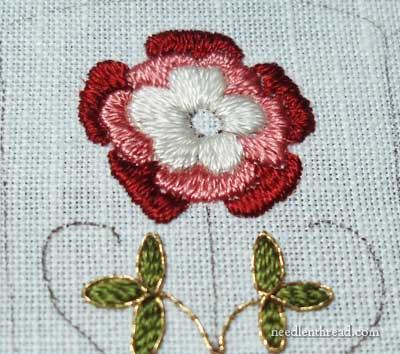
The Floral Glove project is one that I’m rather ferociously determined about, so the idea of doing a little picking didn’t bother me at all. In fact, in such circumstances, picking out stitches is always a good thing!
Although the project is not meant to be symmetrical, I could not find happiness in the look of this flower, which, as you can see, is somewhat sloppily stitched. You can see little bits of white between the layers, for example. I knew there would be some gold in there, but still – I just wasn’t satisfied with the look of it! At the same time, as I approached adding the gold Elizabethan twist around each layer of the flower, my mind boggled at how I would add the gold around the outside layer without plunging on both sides of every outside petal. I really didn’t want to do that.
The only thing for it, then, was to pick out the flower and start over with it.
The stitched flower here is very small – maybe an inch total in diameter. I had plenty of Soie de Paris to stitch another one, because the kit came with full spools of this magnificent thread, and this is really the only element that uses the color, except for a little bit of the red around the outside of the roundels at the base of the project. So, anyway, I had plenty of thread.
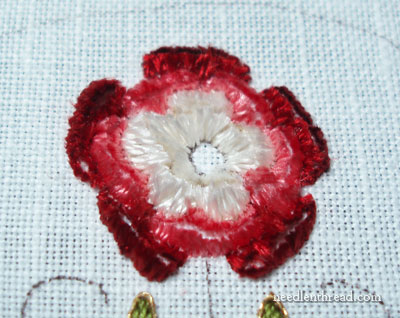
Like all Au Ver a Soie products, Soie de Paris is great. I’ve used the thread before in little applications, but never in needlepainting (long and short stitch) techniques or with satin stitch. It’s dreamy stuff! It’s filament silk, twisted. Some day, I’d like to do a silk project that predominantly features this thread! It reminds me of the silks used at the turn of the last century (1800’s-1900’s) on church vestments – a beautiful sheen, a fine thread, a soft twist. And, because of that twist, it’s a much easier-to-use filament silk than “flat” silks. And (yes, there’s more!), because of the twist, it catches the light a different way. It’s splendid. And it just. feels. good.
I started the stitch-picking by slashing carefully through the satin stitches on each petal of the flower, on the front and on the back.
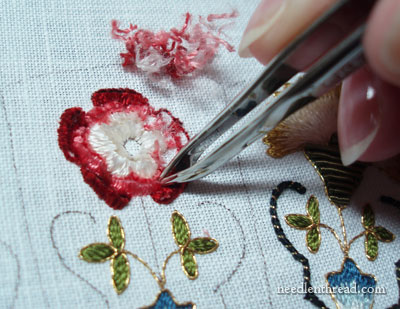
Then, I took out my tweezers (which no embroiderer’s workbasket should be without), and I started picking away.
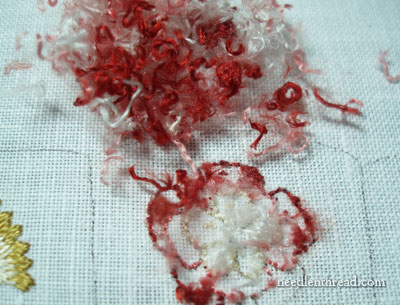
There is always something satisfactory in picking out faulty embroidery stitches. I know, I know!! We tend to think that “frogging” (rip-it, rip-it) is a horrid hassle, and to go through it is a nightmare. But really, the satisfaction of knowing you’re going to put something to rights and love your embroidery all over again makes picking out stitches a wondrous thing!
It actually makes me happy when I get to this point – when I’ve made the decision to pick the stuff out, and I can’t turn back.
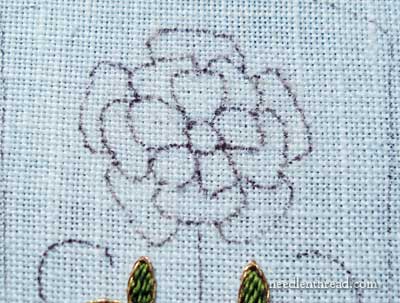
And here we are – back at the original. See, that wasn’t too painful, was it? The fabric withstood the picking just fine.
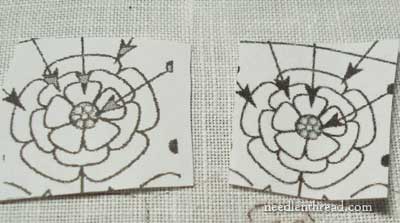
In the instructions, there’s a line drawing that shows what thread is used where with what stitches on the project. So I cut out the flower from the line drawing. The flower on the right above is the original. It was too small to cover entirely the original flower on the fabric, so I blew it up by photocopying the little thing at 110%. This worked great. The flower on the left (above) is the slightly larger flower.
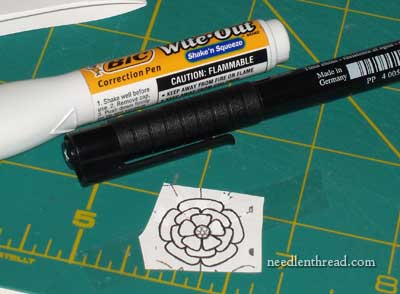
I sat down with a black fine tipped marker and some white-out, and touched up the flower, to get it ready to trace.
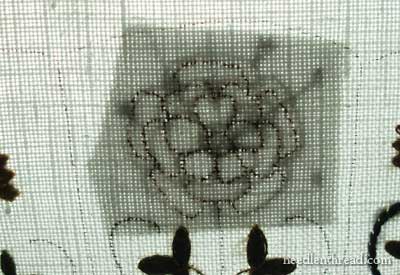
Then, lining up the flower on the back of the fabric while holding the frame up in front of a light, I situated the paper where I wanted and taped it to the back of the fabric. Still holding the piece in front of a light, I carefully traced the larger flower over the area on the fabric with the original flower was.
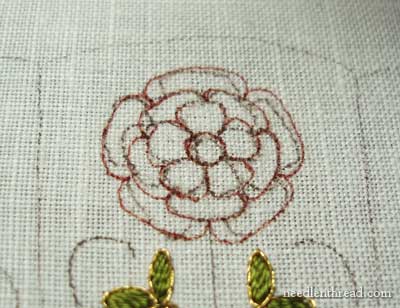
I used a .005 Sakura Micron Pigma pen in brown, so that I could distinguish which lines were which with relative ease. And now that the flower looks the way I prefer it, I think I’ll do a better job stitching it, and I think it will turn out a little better than my first attempt.
So what do you think about ripping out stitches? Does it bother you to do it? Do you ever feel elated once you’ve done it, happy to be on the right track again? Or is it a grumbly thing for you? Do you think I’m being a bit over-persnickity on my stitching on this piece? Would you have left it, or would you have attempted a correction? Leave a comment and let me know!






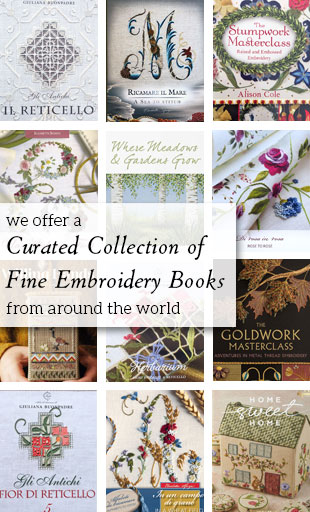
I’ve known very few perfect flowers, so to me your original stitching looked fine. However, I also understand the feeling when the work doesn’t match the picture in my mind. I’m partial to symmetry, too.
Please put the “before” and “after” pictures in your follow-up article.
Very delicate job on the thread removal.
Once you note a mistake it will hit you in the eye each time you look at the project and you will never be happy.
I feel if an area can’t easily be repaired/altered, then it’s best to re-start as you have.
Maureen B
It depends so much on what I’m doing, for whom, and whether it is a practise piece or something that I care about, that I really can’t even guess what my “usual” attitude would be. But once I’ve decided it it needs to be unpicked I just get on with it. So far I have always been glad I did. Although I don’t do it often!
My mom taught me to stitch when I was 5. She is responsible for my 55+ years of stitching passion. Frustration was constant in those early days causing many incomplete projects to sit in the basket. Mom taught me to “strive for excellence, not perfection”. Perfection is rarely attained and can be counter productive, where as excellence gives you the satisfaction that you have done the best you can do. I agree that the fervor is driven by your passion for the project which is another whole topic. If the piece is worth it but you don’t have that feeling that you have tipped the excellence scale – pick it out!! Making a correction changes your focus (even if it not visible to others, they assure you it’s fine). You can then see the PIECE, not just the flaw. When I am dissatisfied, I put the piece down for a while. Then, I go back and reassess after my ire has simmered down. If it still bugs me, it has to go. I fully agree. Picking 🙁 for the sake of excellence! 🙂 Thanks mom!!! Thanks Mary for the tip on photo copying at 110% and re-drawing. Brilliant!!
I design my own projects and part of that process is making all the decisions about stitch type and color. Sometimes a color will work wonderfully in theory, when held up beside its match mates and against the work already put in. But when its worked into the piece sometimes things go wrong and it just doesn’t work like it should. Personally, I know I will never be happy with the piece until I pick out the offending stitches and do it right. I can’t just pretend I meant to do it that way or cast the work aside and let it go. Just night before last, I took out an entire baby elephant because I wasn’t sure the colors didn’t work until I got the third and final value of gray and found that all 3 values were just wrong for the piece. I kept hoping that somehow it would all resolve itself etc etc. Well, that’s what I get for being stubborn – an evening of very carefully and painstakingly teasing out a lot of 18 count cross stitches being oh so careful not to cut the threads of the canvas beneath. Sometimes the color is good but the texture of the stitch I use changes its value or visual weight. But one way or another, I’m a finisher. If I didn’t take it out and do it right that piece would sit on the shelf and natter at me until I took it down and fixed it. Sometimes I really envy people who can just let a project go.
Better sooner than later. While I do more garment sewing than embroidery, no matter the project; if I am unhappy with some aspect have found that taking it back to redo usually leaves me happier. Sometimes I do pretty much what the pattern shows, usually it gets some sort of adjusting or personalizing to suit me. Working from patterns is a nice starting point, though it helps me to view them as just that, a starting point. The important thing is for each needleworker to be true to themselves and work the project in a way that suits them. Sometimes my “adjustments” are wildly successful, sometimes they cause other problems or fail. Still, it makes a more comfortable process for me; and like you, when I am happier with it, I work more effectively with the project. On the other hand if making changes is stressful, then the person is better off continuing on and sticking to the pattern. Either way is OK, there are many different roads to success in handiwork. JMHO, Jane
Thank you for this invaluable lesson on fixing something that bothers me. This session reminds me of the Serenity Prayer…”accept the things I cannot change; courage to change the things I can; and wisdom to know the difference….” Good call, Mary! I’m looking forward to the progression of this project.
I’m working on a project that I designed for my church right now and I just picked out an entire section. It’s a very special project to me and I’m using more expensive threads and fabric than I normally do. As it turned out, the gold thread I had chosen just didn’t work out the way I had hoped and I wasn’t happy with the results. Given that this project is going to take a very long time because of the size and what its intended use is, I couldn’t see putting all of that effort into it only to have part of it not look well done.
At the same time if what I’m making is something for a myself that isn’t going to be on display or if it’s something I can “fudge” on a less special project, I confess that I’m sometimes inclined to leave it. In a certain sense it’s our little mistakes or imperfections which make our projects unique and show that they are handmade (even when we are the only ones who can see the flaw.) It really does depend on the person, like “Jane of Glorious Hats” says above.
Ali
Hi there,
Like the previous comment, I have to admit, my work is more to do with tailoring, dressmaking and at the moment my embroidery is limited to embroidery on my smocking………bullions etc.
However, whether embroidery or hand/machine stitching, I would undo the work if it didn’t look write to me or made me feel uneasy. Yes, excellence is what we are striving for. You will love your pieces if they rise to your standards of excellence. I feel so much happier to unpick and re-do. The satisfaction of finally getting it “right” or as you want it, so that you can feel happy with your work, well that’s priceless and helps you sleep too. LOL.
As usual Mary nothing but admiration for the fact that you post these “blips” and actually bolster our confidence in so doing. We learn that however expert, there are times when a tweek is needed.
Can’t wait to see the finished project.
No Mary, I would not have left it. I am in the process of removing some shadow work that was driving me batty. If it does not make you happy you should do it. After all for the most part, isn’t that why we do stitching?
Perfectionist is hardly a word that fits me. The only stitching I truly enjoy is on crazy quilts which forgives a lot. I do, however, remove stitching, ribbon embroidery, etc. if I look at the total and it seems to take away or somehow jumps out at me as looking out of place. I don’t mind the time that takes at all.
Over the last few years, my attitude about picking out and redoing has changed. Before I loathed it and often just went on without correcting things that bothered me. I think it was Japanese embroidery that changed my attitude. There I tend to do every stitch at least twice before getting it right. And lace knitting–where mistakes just multiply if not fixed. Now I feel that redoing something has benefits. I’m happier with the final project, but I also feel that by undoing a stitch, mofif or row, I understand it better. I get to know the material better, learn nuances about the stitch.I’d still rather not do it–there’s a lot to be said about moving forward and completing a project. I’m doing a lot more ripping than ever and I think my stitching is better than ever, too.
Mary,
I ripped out the stitches on the rose and on the little green leaves. The rose is a stylized flower and I think deserves symmetry, but the leaves were too triangular in the overall form, so I restitched them with a growth curve. I didn’t mind the extra work involved, including gathering all the fluff after I deadheaded the flower.
Joan B
I’ve done a lot of historic costuming, teaching myself the techniques in the decades before we have the resources available now. I realized I had taken a step from ‘just sewing something up’ to really *making* a piece when I didn’t think twice about ripping something out because it wasn’t doing what it should. Sometimes ripping-out multiple times :). That was a milestone in my journey as a costumer and I am seeing it in my embroidery work as well. The time involved is less important than how I want to feel about something when it is finished.
Great work, Mary!
I’m glad you’ve undone that flower lol!
Hi Mary,
You are a perfectionist and that particular section was bothering you even before. I was kind of expecting some changes before long and so I cannot say that I am surprised. I am now waiting to see how the finished project will look like
My mom taught me tailoring when I was 10 years old and one of the tools she gave me in my box was a seam ripper with instructions that I should not hesitate to use it when my stitching was not what I wanted it to be. This is a lesson I have never forgotten and I have never hesitated to rip and redo my embroidery if I was not satisfied with it. I moved away from garment sewing to embroidery and crochet but this is something I still follow.
If I don’t like what I see. I pick it out. I don’t even like giving something away that I don’t like when I look at it. Doesn’t matter that someone else says it’s beautiful. If it’s not right in my eyes, then it gets redone.
Felicidades, no se debe ser obsesiva con la perfección de los trabajos pero sí debemos quedarnos satisfechos del trabajo bien hecho. No todo puede salir bien a la primera y cuando toca deshacer pues se deshace. Yo animo a todas y todos los que hacemos este tipo de trabajos a sentirnos orgullosos de nuestras labores.
Un saludo
Hey Mary,
Stitching is such a journey, isn’t it? Like you – there are times when I rip and restitch until I get it just right. Other times, it doesn’t seem to bother me so much.
I am a little bit different in that there are pieces that I will embrace the imperfection of the design thus create a imperfect piece (although the stitching is perfectly executed, ). I am also working on this glove and have finished all the long/short embroidery with the imperfections which is fine with me.
My thought is that it really comes down to your enjoyment of the design and the stitching of it. I am SO glad you chose to take out the stitching and redraw the lines so that you will enjoy it now and later on.
Isn’t that what the needleart is all about?
GORGEOUS blog!
Christa
For me, I think it would depend on the end use of the project. If it were a gift or going into a show I would unpick (grousing all the while!). But if it were something that was for me and I felt it wouldn’t bother me in the long term, I would tend to leave it alone.
You are just soooo good, Mary! In addition to a beautiful embroideress, you have such courage to let us in “behind the scenes” of your mental process. It is very appreciated. For me, needlework is a passion and I do it because it makes me happy. I always try and remember that! Others can “judge” my stuff with their own criteria, but at the end of the day: Did I get pleasure from it — the process, the end result, etc. I concur that each project can be different depending on how invested I become in it. One thing I notice about myself is that if I push through a project, not correcting the little things that bother me, when it is finished, I have the feeling that I want to do it again — but “right” this time. (That often happens with dress & costume making.) Chances are I will NOT do the same project a second time, but that sensation tells me that I SHOULD HAVE fixed things up the first time through. I am trying to listen more to my own intuition.
By the way, I LOVE Soie d’Paris. It is a beautiful, unique thread. So strong and so shiny. And an “easy substitution” for the sampler-makers out there.
I applaud your efforts! This gorgeous project will please YOU now that you’ve ripped out, retraced, and started again. I take out stitches often (and happily) because,in my experience, if my stitching doesn’t please me when I’m working it, it never will.
I am a firm believer in ‘personalizing’ a project or kit. Sometimes that means a lot of ‘reverse stitching’ (sounds much better than unpicking) and sometimes it means leaving it the way it is. The important point is that you, the stitcher, is happy with the finished project. When I have a glitch in my stitching I put my piece up on the wall with pins, right across from my chair, and I look at it for as long as it takes to make up my mind about it. Sometimes it’s hours, sometimes it’s weeks, or even months. Whether you chose to leave it, restitch it, or give up all together is a personal decision, and as long as you are happy with the end results, that’s all that matters.
“So what do you think about ripping out stitches?”
I have to admit that I do this also from time to time and I can very good understand how you feel about it!
Sometimes it’s also just the easy answer for the question “can I live with this?” – better to rip them out than to be unsatisfied…
I do not think the issue is whether or not a flower in nature is perfectly symmetrical. Perhaps we might discuss reproducing historical needlework. The charm of old or antique needlework is that it was done by hand and the needleworker’s skill and personality are reflected in the piece. In working a reproduction or a piece inspired by antiquities do we need, or even want, to copy those idiosyncrasies? However we choose to approach a project (original or not, reproduction or not) is our choice and by proceeding in this way we make it our own. Mary, you are making this project your own and it’s beautiful.
You call that flower sloppily stitched? hahahaha! I’ll show you sloppy. I have some train wrecks on fabric goin’ on here!
Seriously, I too am Queen of Starting Over. If something isn’t to my liking it just niggles at my brain and everytime I look at piece all I can see is glaring error. Granted I am newbie and some stitches I have not mastered but still. I am working on my first ‘real’ project now to give as a gift and my perfectionism knows no bounds.
One thing I will say, this embroidery hobby has really brought out the nit-picky in me. That may or may not be good thing! I have to give myself a break cuz I am still learning.
Mary, your work just floors me it’s so gorgeous. Something I can aspire to.
I am a perfectionist and bothered by mistakes that, to me, stick out like a sore thumb. That being said, Mary, I advised you to relax and not worry about the shape of the flower or to give it away when finished. I did that because I didn’t want you to worry too much since your embroideries are so beautiful. I wasn’t surprised that you took the “trouble” to fix it since that’s what should always be done as long as there is enough fiber that is! So, long story long, brava maestra!
As a novice stitcher, picking out and starting over seems to be a fact of life. 🙂 But, in doing, I am learning.
Last night, I frogged out some tent stitches done over one thread, on 38 count linen. A total nightmare – but those stitches had to go!
If it’s not right, I’ll never be happy. It’ll be like an itchy spot that won’t go away.
There should be a god we can pray to while frogging, that we don’t cut the ground linen at the same time.
what can I say ^_^ you are a master embroiderer. i don´t think it is because you are a perfectionist, because you must have done embroideries in the past which are not as good as your present works, but back then you thought they are perfect as they are. But if you look at them again, you will start to see the tiniest flaws.
We all develop skills with constant practice, some fast and some slow. It has nothing to do with being perfectionist. Later on, we start to see things that only master embroiderers see. I believe that one develops a higher taste and quality after so many projects. thanks for sharing with us your progress, Mary.
No, I don`t think you are being too persnicity Mary, that rose would have driven me nuts had it been my project. I always grumble about the waste of time involved in picking out, but it`s usually worth it in the end.
Mary, I’m exactly like you. If something I’ve stitched or sewn isn’t the way it should be or how I want it to be, it’s like having a sliver…it will just keep festering and drive me completely crazy. I’ll either have to tear it all out and redo it or I’ll eventually just quit working on it. I’ve learned over time to not even think about it….just fix it right away…in the end, it saves me time and frustration. I am enrolled in the Floral Glove class, too. I just haven’t started it yet, due to some “life” getting in my way, but will start on it soon. I will definately redraw the design before starting on it. Thanks for your interesting and enlightening blog….I truly enjoy it.
Thanks for showing us your correction process, Mary!
Since you had a much more symmetrical drawing in your instructions to use as a model, this seems to me a very
workable solution. Had I your knowledge and that project, I would have done the same! That flower was WONKY. I’m not much of a reproduction stitcher and even while stitching a reproduction (Mary Wigham), I’m correcting her errors. After all, it’s MY stitching and I’ll do what I want with it! While not my favorite thing to do, sometimes ripping and re-stitching are the only answer.
You made the right decision! I think that when you’re unsatisfied with your embroidery it’s better to undo it. I am just facing the same problem, and I will undo some part of my embrodery too!
When something in my stitching does not satisfy me, I cannot go further. I have to redo it. No matter how long it takes.
You took the right decision !
I am in total agreement with Elmsley Rose! Taking the stitches out if they are just wrong is absolutely necessary for me – it drives me nuts every time I work on the piece. But my FEAR if that I will cut the cloth – those little scissors are so sharp! So far, I’ve been lucky. Maybe there is an angle watching over my scissors?
If I make a mistake, I correct it first and then carry on with the project. Sometimes I find it really annoying to redo a piece. But its better to rip and restitch and go on with the work peacefully. I really admire your embroidery skills and thanks for the tips and knowledge you share with us.
Mary ~ I am glad you decided to pick it out. The last row of petals did not look right, maybe the space between them – not sure I cared for the color either.
I take out ~ otherwise it is forever a sore thumb. And, you are right, there is something satisfying about taking out, because you know redoing will be rewarding. If you are even considering picking out, that is your answer – do it, otherwise the thought that it should or should not be done, would not have come into question.
I am a couple days behind on your reading your newsletters – I do look forward to them each day, knowing you are there – even if I don’t have a chance to read for a couple days.
Sharon
Hi Mary,
I don’t think it is a bad thing to pick out things you are not happy with. In fact that is one of the things that I NEED to work on myself. Because if i am not happy with it, my stitching on that area and the rest of the piece gets very “well that is not great so lets not really bother…” I am very bad at ripping out bad areas of my work.
🙂
Mary –
I agree that picking out stitches is a necessary evil at some points. I recently began teaching my best friend to cross-stitch – using the Tinkerbell stamped cross-stitch pillowcase – and we had about an hour long “picking out” session because although I did my best to explain to her, we live 2 hours from each other and my explanation over the phone left something to be desired. I think your work is absolutely beautiful and I am very much enjoying watching your videos on the different stitches. I have, to this point, only ever attempted stamped embroidery and cross-stitch, and one counted cross stitch. I am very much looking forward to learning to embroider without using pre-printed patterns. I am very interested in jacobean-style embroidery and I think your website will be an invaluable tool to help me learn how to improve my needlework. Thank you so much and have a wonderful day!
Kimberly Dillard
Dear Mary,
I must say I couldn’t see anything wrong with that stitching, but I put it down to my inexperience 🙂 Thank you for showing us your “sitakes” and how you deal with them as well as the things that go well. It’s all valuable, especially to us newbies.
I have no problem starting over at the moment. It’s all learning curving – nothing wasted.
Thank you again,
Tessa
Picking out
While I don’t like to pick out things and start over. If I think the error will stand out or bother me, or the project is for a gift, I’ll grumble some, then pick out the mistatke or part I don’t like and start over. If I keep going, usually, I’m not happy with the result. So, I figure it is better to bite the bullet early on so I can enjoy the rest of the process and the finished project.
Hi,Though I dont do such great embroidery, if not satisfied with my work,will immediately rip off the stitches and do the needful until I am satisfied.I normally do embroidery only in dresses and I dont compromise at all.I like the way you do it and the care taken while you pull out the stitches is really great to watch.Your site is very useful and I have learnt a lot from you.Thank you so much for sharing everything with us.
I feel better when I take out stitches I have made wrong or just don’t look right to me. As a new CQ’er and embroiderier. I want to learn the right way. I am very happy I founfd your site.
I agree. If I don’t frog in knitting or embroidery, it’s like the error has a spotlight and my eye goes right there. It’s a pain to rip but worth it in the end as you so beautifully demonstrated!
Hi Mary,
First of all I want to thank you for sharing so indly your passion, your “savoir-faire” and your experiments. I love your site.
Concerning your decision to try to reach perfection I agree. It is no need to keep on embroidering if we are not satisfied with our work. Thanks for showing th way you pick out the stitches badly done.
My English is not perfect but my comment is sincere.
Thank you, Mariezanne, for your kind comment! I’m glad you enjoy the site! 🙂
I felt that I was moving up a level when I decided to pick out and redo stitches on a practice sampler. I was practicing new stitches and intended to leave mistakes but found I couldn’t stand it even on a practice piece.